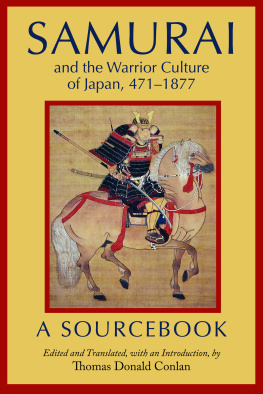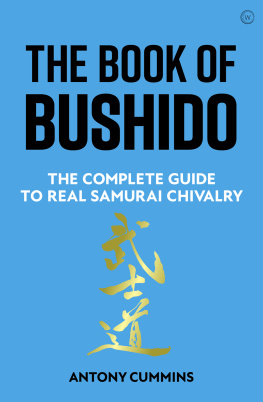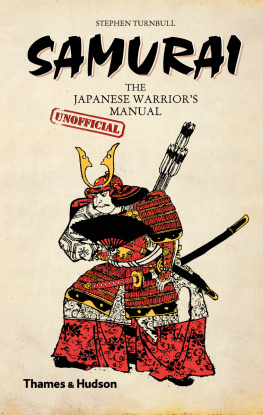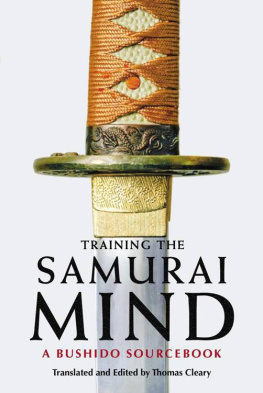Conlan Thomas Donald - Samurai and the Warrior Culture of Japan, 471-1877
Here you can read online Conlan Thomas Donald - Samurai and the Warrior Culture of Japan, 471-1877 full text of the book (entire story) in english for free. Download pdf and epub, get meaning, cover and reviews about this ebook. year: 2021, publisher: Hackett Publishing Company, Incorporated, genre: History. Description of the work, (preface) as well as reviews are available. Best literature library LitArk.com created for fans of good reading and offers a wide selection of genres:
Romance novel
Science fiction
Adventure
Detective
Science
History
Home and family
Prose
Art
Politics
Computer
Non-fiction
Religion
Business
Children
Humor
Choose a favorite category and find really read worthwhile books. Enjoy immersion in the world of imagination, feel the emotions of the characters or learn something new for yourself, make an fascinating discovery.
- Book:Samurai and the Warrior Culture of Japan, 471-1877
- Author:
- Publisher:Hackett Publishing Company, Incorporated
- Genre:
- Year:2021
- Rating:3 / 5
- Favourites:Add to favourites
- Your mark:
- 60
- 1
- 2
- 3
- 4
- 5
Samurai and the Warrior Culture of Japan, 471-1877: summary, description and annotation
We offer to read an annotation, description, summary or preface (depends on what the author of the book "Samurai and the Warrior Culture of Japan, 471-1877" wrote himself). If you haven't found the necessary information about the book — write in the comments, we will try to find it.
Samurai and the Warrior Culture of Japan, 471-1877 — read online for free the complete book (whole text) full work
Below is the text of the book, divided by pages. System saving the place of the last page read, allows you to conveniently read the book "Samurai and the Warrior Culture of Japan, 471-1877" online for free, without having to search again every time where you left off. Put a bookmark, and you can go to the page where you finished reading at any time.
Font size:
Interval:
Bookmark:
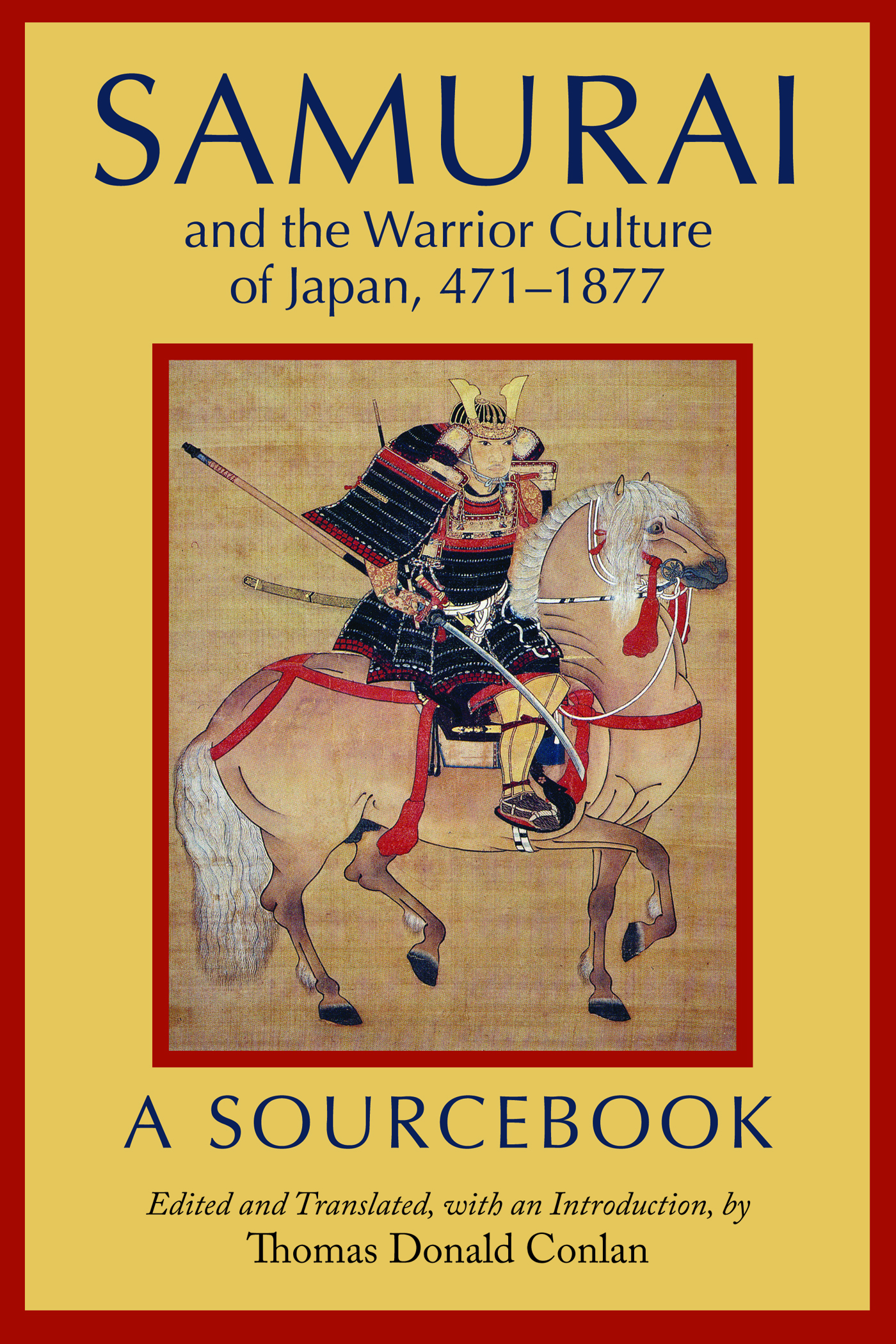
Samurai
and the Warrior Culture of Japan
4711877
A SOURCEBOOK
Samurai
and the Warrior Culture of Japan
4711877
A SOURCEBOOK
Edited and Translated, with an Introduction, by
Thomas Donald Conlan
Hackett Publishing Company, Inc.
Indianapolis/Cambridge
Copyright 2022 by Hackett Publishing Company, Inc.
All rights reserved
Printed in the United States of America
25 24 23 22 1 2 3 4 5 6 7
For further information, please address
Hackett Publishing Company, Inc.
P.O. Box 44937
Indianapolis, Indiana 46244-0937
www.hackettpublishing.com
Cover design by Elana Rosenthal
Composition by Aptara, Inc.
Library of Congress Control Number: 2021945313
ISBN-13: 978-1-64792-056-2 (cloth)
ISBN-13: 978-1-64792-039-5 (pbk.)
ISBN-13: 978-1-64792-057-9 (PDF ebook)
ePub3 ISBN: 978-1-64792-076-0
Matsuo Bash, Bash: Travel Writings . Translated and Edited by Steven D. Carter.
Paul H. Clark, The Perry Expedition and the Opening of Japan to the West, 18531873: A Short History with Documents .
C.T. Assendelft de Coningh, A Pioneer in Yokohama: A Dutchman's Adventures in the New Treaty Port . Edited and Translated, with an Introduction, by Martha Chaiklin.
Contents
The page numbers in curly braces {} correspond to the print edition of this title.
I owe a profound debt of gratitude to several people who helped this book come into being. First, I would like to thank Rick Todhunter for approaching me to do this project, something which I had long wanted to do, and for all his advice and editorial skill. Next, Yoshikawa Shinji aided me greatly in securing images and permissions. He has been a help and inspiration to me for many years. While we were locked down at Princeton, Horikawa Yasufumi aided me with translations of many difficult law codes, letters, and oaths. I learned much from him and truly enjoyed our exchanges, which have immeasurably improved the quality of this book. For securing images at Kyoto University, I am grateful to Iwasaki Naoko, Kido Hironari, and Murakami Yumiko. I also am indebted to Yamada Kotoko of the Saitama Museum for her help and to Roberta Schwartz of Bowdoin College. A special thanks to Elana Rosenthal for her great help in making this a better book during the production process.
Royall Tyler has been a great friend and interlocutor. I have enjoyed our exchanges, both in person during a wonderful few months in Princeton and over email regarding many topics. Royall has been a model for me for scholarly rigor and beautiful prose, and I have learned more from him than words can say. I am grateful for his generosity in allowing portions of his books to be reproduced. I also owe a special thanks to Luke Roberts for generously allowing me to publish parts of his remarkable narrative of Fukutomi Hanemon. Patrick Schwemmer translated the Portuguese version of the 1552 uchi Daidoji document and gave me permission to use it. I have learned much from his erudition. Special thanks, too, to Christopher Mayo for his help with the tomo Sorin documents and source materials. And with the efforts of Iwasaki Naoko and Yoshikawa Shinji, I could see tomo Sorins magnificent saddle in person.
I am especially grateful to Ekaterina Pravilova, for without her help I never could have secured images for the tomo Fransisco cannon. I am in debt to Dr. Sergei Efimov, the deputy director of the Military-Historical Museum of Artillery, Engineering, and Communications Forces, for his photos, permission, and interesting explanation of this remarkable object and its storied history. Kurushima Noriko introduced me to the existence of nineteenth-century petitions for reward. Wada Shusaku also proved helpful in explaining military documents of western Japan. Finally, Ebara Masasharu earns my thanks for informing me of the existence of this cannon in the first place.
I owe great thanks to Mark Ravina for introducing me to The Japan Mail translation of the edict abolishing the samurai, as well as his erudition regarding the events of the 1870s. I am also grateful to Gregory Smits regarding the social orders of Okinawa. Jaqueline Stone has always been a source of knowledge and inspiration. I have also learned a tremendous amount from Andrew Watsky. Thanks, too, for Shel Garons and Federico Marcons insights and suggestions. And finally, I am grateful to Michael Como, Brian Steininger, and Bryan Lowe for their help in deciphering and translating ancient swords.
My students have been a great help and inspiration for this project. In particular, the graduate students who took my Sources in Ancient and Medieval Japanese History class over the years. Kyle Bond, Gina Choi, Claire Cooper, Antonin Ferr, Megan Gilbert, Filippo Gradi, Joseph Henares, Kentaro Ide, Caitlin Karyadi, Nate Ledbetter, Skyler Negrete, David Romney, Michelle Tian, and Mai Yamaguchi have contributed much to my knowledge of documents, and they have aided in some translations. Undergraduate students in my Origins of Japanese Culture and Civilization course in the spring of 2018, 2020, and 2021 tested out some translations and helped me to improve them, as well as students in my Warrior Culture of Japan course, and the students in Rob Hellyers Japanese history course at Wake Forest University.
{xiii}
Becoming Samurai : The Warrior Culture of Japan
Beginning with sword inscriptions (the oldest known writings related to Japanese warriors), this book is arranged more or less chronologically, proceeding on to works of court literature, diaries, letters, documents, and law codes as well as portraits and picture scrolls. It aims to show that an autonomous and unique warrior culture arose and thrived and explores warriors roles as fighters, guards, lawgivers, and managers and traces their rise in Japanese societyfrom bodyguards to marginal provincial figures to autonomous warriors, and finally, in some cases, to provincial magnates and dominant rulers over all of Japan. Included here are such illuminating texts as the late sixteenth-century documents formalizing the creation of the samurai order as well as ordinances from the 1870s abolishing that very same order.
A Brief Overview of Japanese History 4711877
The warrior culture of the earliest centuries covered in this book (471900) is revealed through inscriptions on five swords, two of which contain the earliest known writing in Japan. They date from the time of the Great King Yryaku (known then as Wakatakeru) and correspond to a time of extensive immigration to his Yamato kingdom. These immigrants, primarily from the Korean peninsula, brought with them new beliefs, such as their ancestral gods; new technologies, including writing; and a new means of recording time through a Chinese calendar.
The powerful Yamato kings had massive tombs, requiring millions of hours to construct, and undoubtedly controlled extensive armed forces. Some Chinese histories refer to the Yamato leaders as great generals who maintained peace and commanded all military affairs with their battle axes. However, after Yryakus time, the tombs decreased in size. In chronicles dating from 712 and 720, Yryaku is portrayed as being a cruel and arbitrary leader. But we can tell, from looking at his swords, that his reputation began to suffer even sooner than that. One of his swords, which had at some point been owned by a prominent magnate {xiv} ( kuni no miyatsuko ), eventually ended up in the hands of a far lesser figuresomeone who could not afford a lavish tomb but was instead roughly buried on top of another mans tomb. The disgraced Yryakus gifts were shunned by the powerful, even in a time when great value was placed on a good sword.
Font size:
Interval:
Bookmark:
Similar books «Samurai and the Warrior Culture of Japan, 471-1877»
Look at similar books to Samurai and the Warrior Culture of Japan, 471-1877. We have selected literature similar in name and meaning in the hope of providing readers with more options to find new, interesting, not yet read works.
Discussion, reviews of the book Samurai and the Warrior Culture of Japan, 471-1877 and just readers' own opinions. Leave your comments, write what you think about the work, its meaning or the main characters. Specify what exactly you liked and what you didn't like, and why you think so.

